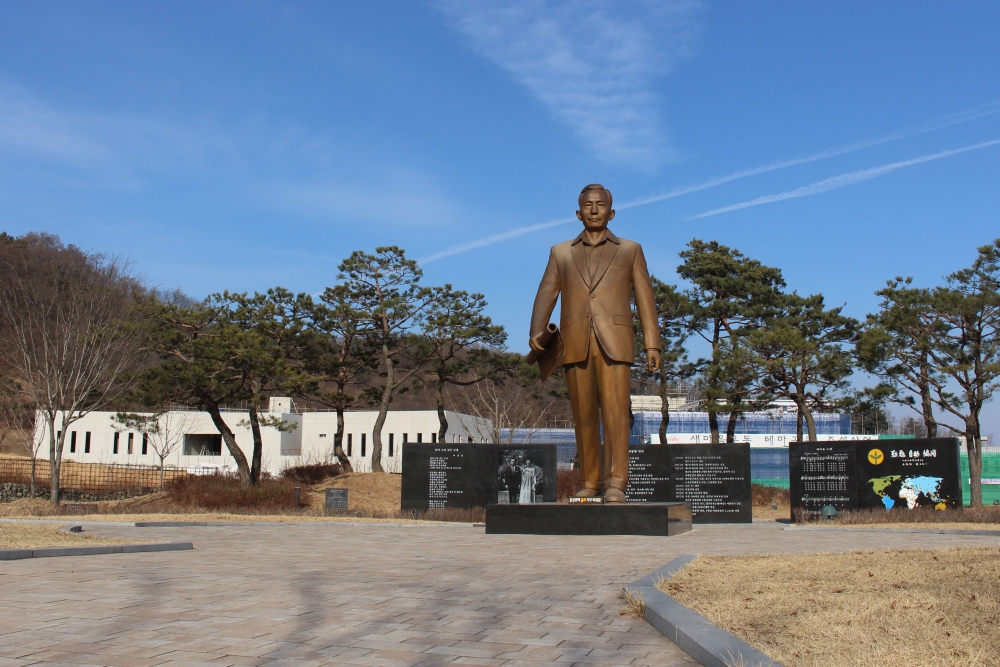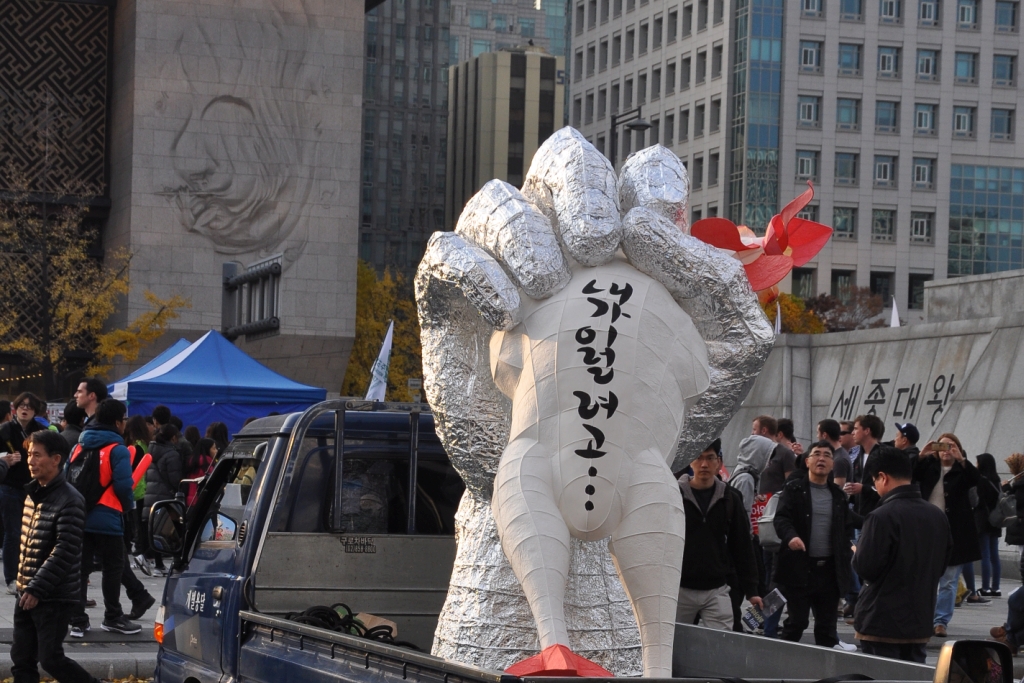
Dispatch from Gumi: Park Geun-Hye's Sins Taint Father's Legacy
The monument to a dictator sits at the foot of some rolling hills, and visitors approaching the entrance are greeted by a bronze statue that depicts workers doggedly dragging a wheelbarrow. Nestled into trees behind the sculpture is a small cluster of gleaming single-story buildings: the house where Park was born; and the President Park Chung-hee National Restoration Hall, a museum dedicated to Park’s life and presidency.
Since the complex opened in 2015, Lee Gwan-cheol has made regular visits here. Lee, 67, says that every two or three months he makes the drive from his rural home in Punggi, a nearby village, to take a stroll around the wooded grounds and read stories about the life of former President Park Chung-hee. He says he draws strength from the narrative of Park’s legacy.
“When I was young, we didn’t have enough to eat. I wasn’t able to study because my family needed me to work. Nowadays more than 80 percent of young people in this country go to university. We’re number one in the world in that measure, and it’s because of him,” Lee said while gesturing to a photo of Park.
In his teens, Lee found work on construction sites, and eventually opened his own company. He says the youths of today’s South Korea have it much easier than he did, but are unappreciative of the sacrifices that went into building the country. “Young people today go to school and only learn about the bad things of that era; they aren’t taught the good things he did,” Lee said of Park.
Nowadays, Park Chung-hee’s legacy is under renewed scrutiny, with his daughter, President Park Geun-hye, in disgrace after a December 9 vote for her impeachment. If the Constitutional Court upholds the impeachment motion, Park is likely to face criminal charges for her role in helping confidante Choi Soon-sil extort major corporations and exert influence over state affairs. (A sitting president is immune from prosecution.)
The backlash against Park and her involvement in the biggest scandal South Korea has seen in decades is also palpable in Gumi, the country’s conservative heartland and a traditional stronghold of support for the Saenuri Party.
Gumi residents’ fealty to the city’s most famous son, and by extension, his daughter, appears to be waning. The centerpiece of the complex is the elder Park’s birthplace, which is now off-limits to visitors, as it was damaged in an arson attack in early December. Police told local media that after being apprehended, the alleged arsonist admonished Park Geun-hye not to “smear shit in her father’s name.” About a month earlier, graffiti was found on a nearby statue of Park: the Korean word for “dictator,” written in runny, blood-red letters.

They are both signs that the popular backlash against Park over the scandal has tainted her father, too. It certainly colored the annual ceremony in November to mark Park Chung-hee’s birthday. Picketers came to the somber ceremony calling on President Park to be impeached, and only 500 well-wishers showed up, a big drop off from the average of 1,500 in previous years.
Her father’s legacy was a reliable touchstone for Park throughout her political career. She won the election in 2012 drawing on support from older and conservative voters with fond memories of her father’s era. The elder Park’s reign, 1961-79, was a time of South Korea’s most significant development, and he is credited by many in South Korea with guiding the country’s transition from decimated postwar backwater to industrialized wealth.
The area around Gumi was one of the big beneficiaries of this change, becoming a rich industrial hub. Perhaps reflecting the local memory of that favor, 69% of respondents to a poll by Gallup Korea from the Daegu/North Gyeongsang Province area (where Gumi is located) were for Park’s impeachment, a comfortable majority but by far the lowest rate recorded nationwide, and lower than 83% in Seoul and 94% in the traditionally liberal Gwangju/Jeolla Province region (which incidentally saw few benefits during the brisk economic development under Park’s father).
On a sunny, unseasonably warm, crisp Sunday afternoon, there were almost no visitors to the memorial complex, save for a smattering of middle-aged couples. In conversations with visitors, a consensus emerged that that the sins of the daughter shouldn’t affect how her father is remembered. “Park Chung-hee had no role in this [the Choi Soon-sil scandal], and he wasn’t like his daughter; he wasn’t out for money. He put the country first,” said Kim Seung-man, a 52-year-old taxi driver taking a break from his work to walk around the park that abuts the exhibition hall.
The project of setting up this combination — museum, park and memorial — started in 2006 and was completed in 2015, using 28.6 billion won in funding from Gumi and North Gyeongsang Province governments. At the front desk of the President Park Chung-hee National Restoration Hall, one staff member sat listlessly scrolling through her smartphone. Admission is free, she said. Come on in.
The exhibition is filled with images that would be familiar to visitors of the hit blog Kim Jong-il Looking at Things. President in hardhat at construction site. President in conference room listening as official points to map. President in countryside smiling at rural folk.

The qualities that Park Chung-hee’s supporters attribute to him – diligence, triumphing over long odds through hard work and perseverance – run through the museum. The first display depicts Park as a boy, reading a book under a tree. A theater space that shows a film about Park’s life is called Can Do Hall. An exhibition about Park’s spearheading of a highway connecting Seoul and Busan hailed him as a visionary rising above naysayers who contended that South Korea didn’t have enough cars to warrant such a large investment in infrastructure.
One interactive display seeks to recreate Park’s industrializing touch: by tapping a screen, visitors can turn thatched huts into modern, brick and mortar houses, a gravel path into a paved road, trees into electric street lights.
The museum clearly intends to glorify Park; there is no mention of how as president he suspended civil and political rights. Park’s use of his fellow military men to seize power on May 16, 1961 is described as a “revolution” in lieu of the most commonly used “coup.” (The elder Park is also called General Park Chung-hee, usually by those who focus on his military background to emphasize that he was not a democratically elected leader.) Also notably absent from the exhibition is any mention of Japan. Traversing the exhibit, there is no indication that for part of his career Park went by the name Masao Takagi and once pledged allegiance in blood to the Emperor of Japan.
A short walk from Park’s birthplace and the museum is a walkway that culminates in a five-meter tall bronze statue of the late president. The statue depicts Park looking forward with a no-nonsense expression while holding a blueprint in his right hand.
There were no one around until a couple of university students strolled by. Were they here show their appreciation for Park’s service to the country? “I think he did well,” said Choi Young-cheol, a 20-year-old university student, while holding hands with his girlfriend, counter to Lee’s opinion about ungrateful youths.
He added that he was still in favor of impeaching Park, before saying, “We didn’t come here to talk about politics. We just wanted to find a quiet place to take a walk.”
Cover Image: A five meter-tall statue of General Park Chung-hee, the father of the current president Park Geun-hye and South Korea’s longest-ruling dictator, overlooks a complex dedicated to his memory in the city of Gumi where he was born. (Steven Borowiec/Korea Exposé)

